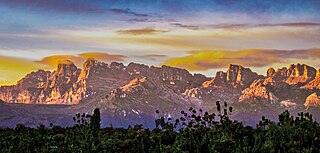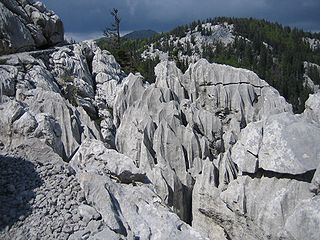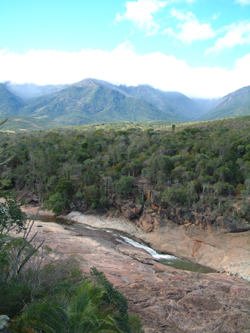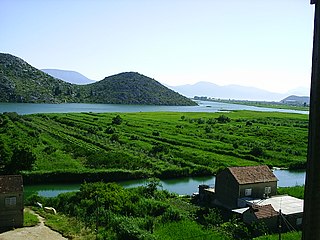
Plitvice Lakes National Park is one of the oldest and largest national parks in Croatia. In 1979, Plitvice Lakes National Park was inscribed on the UNESCO World Heritage list, due to its outstanding and picturesque series of tufa lakes, caves, connected by waterfalls.

The Kornati archipelago of Croatia, also known as the Stomorski islands, is located in the northern part of Dalmatia, south from Zadar and west from Šibenik, in the Šibenik-Knin County. With 35 kilometres length and 89 islands, some large, some small, in a sea area of about 320 square kilometres (124 sq mi), the Kornati are the densest archipelago in the Mediterranean Sea. From northwest to southeast, and from northeast to southwest they stretch for 13 km. The name of the archipelago is the plural form of the name of the largest island, called Kornat.

Zadar County is a county in Croatia, it encompasses northern Dalmatia and southeastern Lika. Its seat is the city of Zadar.

Lorentz National Park is a national park located in Central Papua, Indonesia, in the southwest of western New Guinea. With an area of 25,056 km2 (9,674 mi2), it is the largest national park in Southeast Asia. In 1999 Lorentz was declared a World Heritage Site by UNESCO.

Velebit is the largest, though not the highest, mountain range in Croatia. The range forms a part of the Dinaric Alps and is located along the Adriatic coast, separating it from Lika in the interior. Velebit begins in the northwest near Senj with the Vratnik mountain pass and ends 145 km to the southeast near the source of the Zrmanja river northwest of Knin.

Tourism in Croatia is a major industry of country's economy, accounting for almost 20% of Croatia's gross domestic product (GDP) as of 2021.

The Northern Velebit National Park is a national park in Croatia that covers 109 km2 of the northern section of the Velebit mountains, the largest mountain range in Croatia. Because of the abundant variety of this part of the Velebit range, the area was upgraded from a nature reserve in 1999, and opened as a national park in September the same year.

Plitvička Jezera is a municipality (općina) in central Croatia, in the eastern part of the Lika-Senj county, that lies in and near the eponymous Plitvice Lakes National Park, bisected by the D1 main road (Zagreb–Split). Its total area is 539.08 km2 The main town and seat of the municipality is Korenica. Smaller towns and villages are Bjelopolje, Jezerce, and Ličko Petrovo Selo.

The national parks of Madagascar include all officially recognized protected areas as of 2015. The protected areas network of Madagascar is managed by the Madagascar National Parks Association (PNM-ANGAP). The network includes three types of protected areas: Strict Nature Reserves, National Parks and Wildlife Reserves. At the 2003 IUCN World Parks Congress in Durban, the Malagasy President, Marc Ravalomanana, announced an initiative to more than triple the area under protection from approximately 4,200,791 acres (17,000.00 km2) to over 14,826,322 acres (60,000.00 km2). This "Durban Vision", as it has been dubbed, involved broadening the definition of protected areas in the country and legislation has been passed to allow the creation of four new categories of protected area: Natural Parks, Natural Monuments, Protected Landscapes, and Natural Resource Reserves. As well as allowing these new objectives for protected areas management, the new legislation also provided for entities other than PNM-ANGAP to manage protected areas, such as government ministries, community associations, NGOs and other civil society organizations, and the private sector.

Protected areas of Poland include the following categories, as defined by the Act on Protection of Nature of 16 April 2004, by the Polish Parliament:
Protected areas of Sri Lanka are administrated by Department of Forest Conservation and Department of Wildlife Conservation of Sri Lanka.There are 501 protected areas in Sri Lanka. The protected areas that fall under supervision of the Department of Forest Conservation include forests defined in National Heritage Wilderness Area Act in 1988, forest reservations, and forests managed for sustainability. Sinharaja Forest Reserve is an example for a National Heritage forest. There are 32 forests categorized as conservation forests including Knuckles Mountain Range. Strict nature reserves, national parks, nature reserves, forest corridors, and sanctuaries recognized under the Flora and Fauna Protection Ordinance are managed by Department of Wildlife Conservation. Total of all protected areas is 1,767,000 ha. Protected areas in Sri Lanka account for 26.5 percent of the total area. This is a higher percentage of protected areas than in all of Asia and much of the World.
Piškera is a small uninhabited island in the Croatian part of the Adriatic Sea. It is one of the Kornati Islands in central Dalmatia and its area is 2.66 km2. Its coastline is 10.64 km long.
The Register of Protected Natural Values of the Republic of Croatia has been created according to the Nature Protection Act in 2005. The register is being administered by the Administration for Nature Protection within the Croatian Ministry of Culture. The register serves as a reference database and unique official data source about protected areas in Croatia. The data in this register is public with the exception of special cases of confidentiality regarding the position of certain protected natural goods. The Nature Protection Act stipulates nine categories of protected areas.
Protected areas of Ukraine are special areas of Ukraine established with the goal of protecting the natural and cultural heritage of the country from excessive changes as a result of human activity. The protection of the areas is the responsibility of the government of Ukraine, specifically the Cabinet of Ministers of Ukraine.
Categories of Natural Environment Protected Areas of Ukraine were reestablished (redefined) by the Verkhovna Rada after the fall of the Soviet Union. On 16 June 1992 the President of Ukraine Leonid Kravchuk signed the law on the Nature-Preservation Fund of Ukraine. The law redefined already the established system of environment protection management for Ukraine as a fully sovereign and independent country. National Parks in Ukraine and other protected areas of Ukraine include Ramsar sites in Ukraine, biosphere reserves of Ukraine, National Nature Parks of Ukraine, Nature Reserves of Ukraine, Regional landscape parks of Ukraine, Nature monuments of Ukraine, Protected tracts of Ukraine and Habitat/Species Managed Areas of Ukraine.

Una National Park was established on 29 May 2008 around the rivers Upper Una River, Krka and the Unac. It is Bosnia and Herzegovina's largest national park. The main purpose of the park is to protect the unspoiled Una river and its tributaries Krka and Unac, which run through it.

Neretva Delta is the river delta of the Neretva, a river that flows through Bosnia and Herzegovina and Croatia and empties in the Adriatic Sea. The delta is a unique landscape in southern Croatia, and a wetland that is listed under the Ramsar Convention as internationally important, as the wetland extends into the Hutovo Blato in Herzegovina.

Štirovača is an Old-growth forest in North Velebit. It is a nature reserve with abundant forest vegetation which covers the area of 118.5 acres. Majority of the forest extends to an altitude above 1100 meters above sea level and is composed mostly of beech, spruce and rowan. The area was once more densely covered with forest, but today a small part of the towering forests remain in Štirovača. This type of the spruce forest (Aremonio-Piceetum) is a relict boreal vegetation that existed in the ice ages, and which stretched far further to south than today's southern border. The land favors podzol soil, high elevation which is required for this type of trees in these latitudes and a relief position, so these forests occur in sinkholes, bays and gorges of Croatian highlands. This is because unique microclimate conditions are present, most notably the cold air is accumulated, and frost areas prevail throughout the year because of the appearance of temperature inversions, and thus the conditions are created for spruce to become more competitive when compared to other tree species.

































